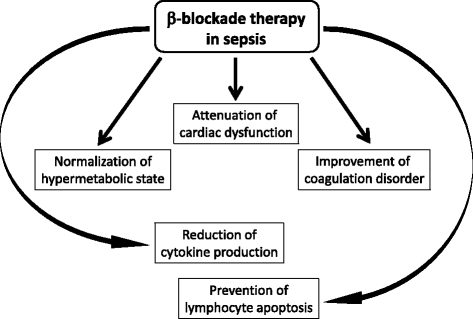Sepsis-induced cardiac dysfunction and β-adrenergic blockade therapy for sepsis
- PMID: 28270914
- PMCID: PMC5335779
- DOI: 10.1186/s40560-017-0215-2
Sepsis-induced cardiac dysfunction and β-adrenergic blockade therapy for sepsis
Abstract
Despite recent advances in medical care, mortality due to sepsis, defined as life-threatening organ dysfunction caused by a dysregulated host response to infection, remains high. Fluid resuscitation and vasopressors are the first-line treatment for sepsis in order to optimize hemodynamic instability caused by vasodilation and increased vascular permeability. However, these therapies, aimed at maintaining blood pressure and blood flow to vital organs, could have deleterious cardiac effects, as cardiomyocyte damage occurs in the early stages of sepsis. Recent experimental and clinical studies have demonstrated that a number of factors contribute to sepsis-induced cardiac dysfunction and the degree of cardiac dysfunction is one of the major prognostic factors of sepsis. Therefore, strategies to prevent further cardiomyocyte damage could be of crucial importance in improving the outcome of sepsis. Among many factors causing sepsis-induced cardiac dysfunction, sympathetic nerve overstimulation, due to endogenous elevated catecholamine levels and exogenous catecholamine administration, is thought to play a major role. β-adrenergic blockade therapy is widely used for ischemic heart disease and chronic heart failure and in the prevention of cardiovascular events in high-risk perioperative patients undergoing major surgery. It has also been shown to restore cardiac function in experimental septic animal models. In a single-center randomized controlled trial, esmolol infusion in patients with septic shock with persistent tachycardia reduced the 28-day mortality. Furthermore, it is likely that β-adrenergic blockade therapy may result in further beneficial effects in patients with sepsis, such as the reduction of inflammatory cytokine production, suppression of hypermetabolic status, maintenance of glucose homeostasis, and improvement of coagulation disorders. Recent accumulating evidence suggests that β-adrenergic blockade could be an attractive therapy to improve the prognosis of sepsis. We await a large multicenter randomized clinical trial to confirm the beneficial effects of β-adrenergic blockade therapy in sepsis, of which mortality is still high.
Keywords: Sepsis; Sepsis-induced cardiac dysfunction; β-adrenergic blockade therapy.
Figures


References
Publication types
LinkOut - more resources
Full Text Sources
Other Literature Sources

